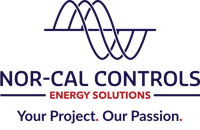Solar tracker systems are an advanced technology for mounting PV panels. They use motors to automatically move the panels to follow or "track" the progress of the sun, orienting them so that sunlight strikes at an optimal angle to the panel’s surface. This maximizes the ability of the panels to convert incoming light into energy.
Solar PV tracker systems are complex and produce large amounts of data. As such, they can have a major impact on the performance and function of the site's SCADA system. Here's what you need to know about integrating a solar PV tracker system with SCADA.
1. What capabilities does a SCADA system need for monitoring and controlling solar PV trackers?
To monitor and control solar PV trackers, your SCADA software must have the capability to read data from the tracker system you're using. Most tracker systems provide data over Modbus TCP/IP protocol, which can be easily read by most SCADA software. At Nor-Cal Controls, we typically use GE Cimplicity or Ignition SCADA software, both of which can read data from standalone tracker systems.
You can learn more about SCADA communication protocols here.
2. Do standalone tracker systems typically have their own monitoring and control software, or will the SCADA system need to be able to control the tracker? If they have their own software, what kind of controls capabilities are usually included?
Most modern tracker systems, like Nextracker and ATI, incorporate their own control systems. The SCADA system doesn't have anything to do with these standalone tracking-level controls, but it must be able to send commands to the tracker controllers that are located at each inverter pad.
For example, if there is a wind event coming in, the plant operator must be able to stow all the trackers, which means positioning the trackers parallel to the ground so that the panels don't suffer wind damage. The operator does this by sending a command to the tracker controllers from the SCADA system. The tracking-level control system then stows the trackers.
Certain tracking systems, such as Nextracker, also come with their own monitoring system. It's not a full monitoring software, but rather a software or interface from which you can check the health of the tracker motors, battery charging, and motor alarms.
This sounds small, but it can offer a significant advantage if you have a large plant. While some tracking systems, like ATI, have just a handful of motors that each handle multiple rows of panels, others, like Nextracker, have one motor per row of panels. For a large utility-scale plant—let’s say 200 or 300 megawatt AC capacity—that can easily add up to 6,000 motors or more. If you want to monitor all those motors using your SCADA system, doing so will add a tremendous number of data points on top of the thousands the system is already handling. The system will get heavy and require more processing power. SCADA software is priced based on tag or point count, so your expenses will also increase along with the engineering and implementation costs. Having separate tracker monitoring software helps you avoid these issues.
That said, while the detailed monitoring can be handled by the tracker monitoring software, you can still use the SCADA system for overall monitoring of the tracker system. For example, you can monitor a particular block of motors to ensure all motors are functioning and the trackers' overall health is good.
3. Are there certain tracker system designs that better integrate into SCADA systems over others?
As long as the tracker system sends data via a protocol that can be easily read by SCADA software, it can integrate with the SCADA system. As mentioned earlier, most tracker systems use Modbus protocol. At Nor-Cal Controls, we can integrate with proven tracker systems like Nextracker and ATI, which have been on the market for a long time and are easy to integrate. However, there are newer systems that are also widely used, like GameChange, that can also integrate with SCADA systems.
4. What are the device or point count concerns for integrating into the SCADA system?
Device and point count are major concerns when it comes to integration. As covered earlier, the tracker motors can add thousands of data points depending on the system you use. More data points means higher costs and processing power. The tracker controllers also contribute data points. Some tracker systems have one controller per inverter pad, while others have two or more. The number of data points per controller also varies by system. Some controllers provide granular feedback about tilt row and other metrics, which also add data points.
Here are some ways to mitigate this so that the volume of data doesn't overwhelm the SCADA system:
- As covered earlier, tracker-level monitoring software allows you to get detailed data about the motors without pulling it all into the main SCADA system. At Nor-Cal, we recommend utilizing this.
- You can weigh the value of granular information against the extra cost and performance considerations. Knowing the tilt row may be helpful, but may not be worth the extra point count. Consider which points are absolutely necessary for operators to monitor through the SCADA system and only bring those in.
For more on this topic, read our article: How Trackers Affect SCADA System Costs & Performance
5. How do tracker systems communicate with the SCADA system?
Tracker systems communicate with the SCADA system via Modbus protocol over fiber optic cables. Modbus is the language and fiber is the communication medium.
In a typical layout, there is a field network communication enclosure at each inverter pad location near the tracker controllers and motors. These outdoor-rated enclosures contain a piece of networking equipment called a switch, which connects the field devices (including the trackers) and allows them to communicate via Ethernet. These field switches then connect back via fiber optic cables to a main root switch at the substation control house where the SCADA server is located. This network allows the SCADA system to send commands to the tracker system controllers and for the tracker system to send data back.
Learn more with our articles on Communication Protocols and SCADA Networking Equipment.
6. Can tracker systems be wireless and what are the advantages and disadvantages to using wireless based on Nor-Cal's project experience?
Some tracker systems can use wireless communication between the controllers and motors, mostly via Zigbee protocol over digital radio. However, even though we can commission them, we do not typically recommend using wireless tracker systems for the projects we work on.
Most large solar PV plants are in remote areas that are subject to high winds, high temperatures, and other environmental conditions that can cause disrupted signals or loss of communication. If there are too many wireless devices, they can clash with each other and take down some of the communication systems. That is why most site owners prefer fiber for large projects despite the higher initial costs. Once the cable is safely secured in the weatherproof enclosures and underground trenches, you don't have to worry about it.
7. Which HMI graphical screens need to be included with the SCADA system to represent the trackers? What are some typical tracker system alarms that should be integrated into the SCADA system?
Tracker systems produce a lot of data. Like SCADA software, HMI software is typically tied to point count, so in the interest of cost and integration time, you won’t want to pull in everything. Keep in mind, the data must also be depicted on the HMI screens in a way that's useful and actionable for operators.
We typically recommend a graphical screen that includes commands the operator can send to the tracker controllers. Stow, as mentioned earlier, is a crucial command that prevents severe damage to the PV panels in a wind event. Other commands include sending a set point for the tracker angles, putting a row in clean mode, and putting the tracker system in auto or manual mode.
On the monitoring side, operators need quick visualization of battery health, overall controller and motor health, alarms, and the current setpoint angle of the tracker system.
Alarms alert the operator if a tracker motor is running at too high a temperature due to high current or high voltage. If not resolved, this can lead to motor failure. Motor stuck is the most important tracker alarm as trackers can get stuck on any angle, including parallel. Alarms can also alert the operator of any tracker controller problems.
It's also important for operators to be able to compare the current setpoint angle with the actual tracker angle. If there is a discrepancy (for example, the current tracker setpoint is 50 degrees West but after five minutes the trackers are still at 40 degrees), this will cue the operator that the trackers are stuck even if there is no alarm. The operator can then dispatch onsite personnel to fix the issue.
How can Nor-Cal help with your solar PV tracker system?
We have experience with all of the major tracker system OEMs, and our extensive controls experience enables us to work with newer OEMs as well. Since our SCADA systems are based on open architecture hardware and software, we're agnostic when it comes to the trackers that are selected for our projects. This means you're never locked into one OEM or design.
If you have questions about what type of system or OEM would be best for your solar PV project, we can help. Schedule a call with us today.





